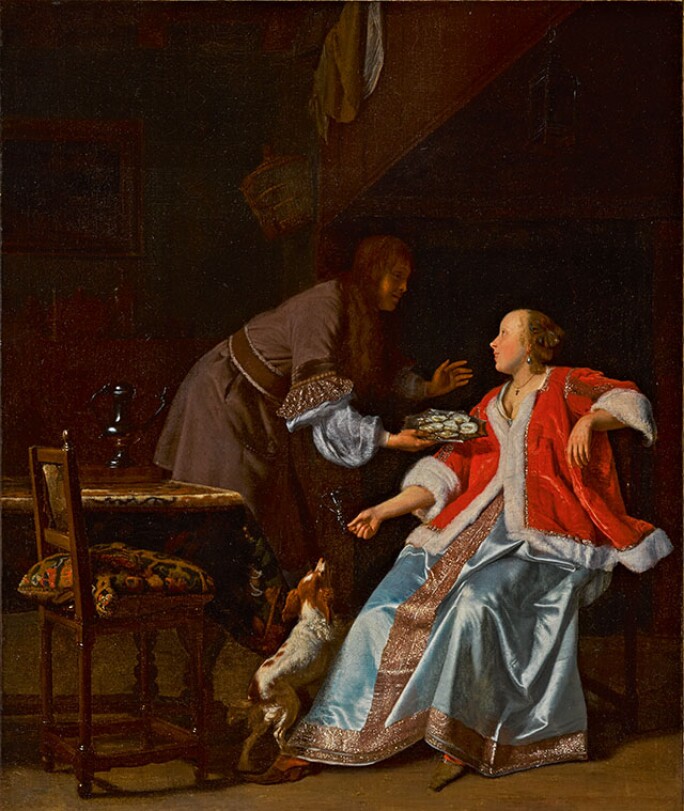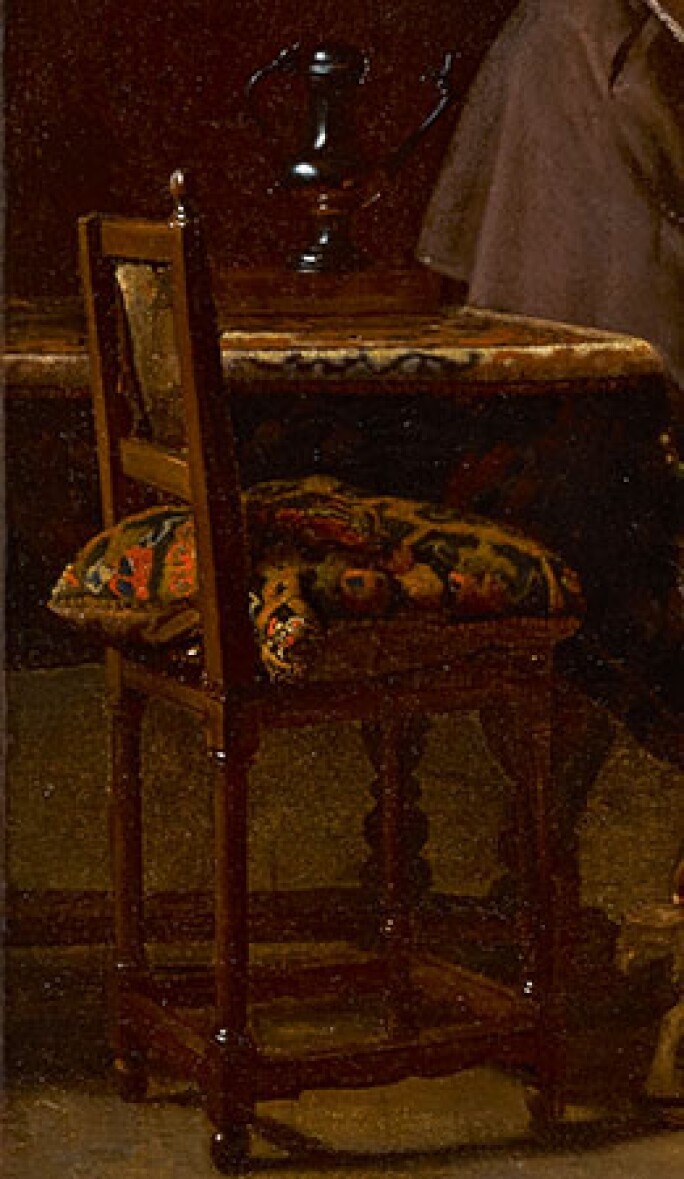C harlotte Smidt van Gelder - known as Hetty to friends and family - was a teenager in 1936 when her father Joan brought home a painting which made an immediate impression on her. It was The Oyster Meal, a 17th century work by the Dutch Golden Age master Jacob Ochtervelt, a delicate, witty interior scene which captured the imagination of the young girl. “I loved it from the moment I saw it,” she recalls, “the way the silk of the woman’s dress was painted so beautifully, and the little dog at her feet! The whole family loved it. We didn’t like every painting our father brought home, but this was a good choice, we thought.”
Her father had a good eye. Ochtervelt was a contemporary of Dutch masters Johannes Vermeer and Pieter de Hooch, and The Oyster Meal is regarded as a lovely example of that period’s greatest genre works. The seduction scene, in which a suitor tempts an expensively-attired young woman with a dish of oysters, is laden with symbolism, most of it sexually suggestive, while the artist’s technique is rendered with exquisite refinement.
The 97-Year-Old Reunited with her Nazi-Looted Masterpiece
George Gordon, co-chairman of Old Masters Worldwide at Sotheby’s, points to a decanter in the darkness to the left of the painting, in which there is the subtlest of reflections from the woman’s down-seamed red jacket. It is a work to be appreciated, he says, for its deft blend of sensuality and humour: the woman seems to be offering the dog a sip of her wine, which is already spilling to the ground, in order to compromise the hound’s vigilance in protecting his mistress’s virtue.
Hetty’s father was a paediatrician, medical director of the Kinderziekenhuis (Children’s Hospital) in the Dutch city of Arnhem. His new acquisition - he had been a collector of art and antiques since the age of 18 - was hung in the waiting room of his house, where he also saw patients. “It was such a cosy picture,” says Hetty. “I used to look at it for hours.” Her eye for detail, inherited, she says, from her father, focused on a chair to the left of the main scene, which was missing one of its two decorative pommels on the back. Its absence may have been more contemporary symbolism, or a piece of whimsy by the artist.
Little did any of the family members realise that the missing pommel would turn out to be a key element in helping to trace the subsequent, tortuous history of The Oyster Meal in the years since its happy homecoming that day.
Hetty Smidt van Gelder, a slim, impossibly vivacious 97, lives on her own in the town of Zeist, east of Utrecht, in an apartment block with its own swimming pool, which she uses daily. She vividly recalls the dark days of 1940, as Nazi Germany threatened, then attacked, and then finally occupied the Netherlands in the spring. She remembers being out one evening and hearing some ominous noises which seemed to come from the far distance. “I wondered if I should wake up my parents when I got home, but I decided to let them sleep. But we were all woken at 4 am by a massive explosion.”
The days which followed the invasion of the German army were a “horrible” time, she says. “I saw all these poor boys around me, they became old men overnight.” The occupiers at first encouraged the local people to get on with their lives, but it wasn’t long before their more sinister intent made itself felt. Joan Smidt van Gelder had already sent his art collection for safe keeping in a storage space of the family company in Amsterdam. He felt confident enough to bring some of the paintings back home temporarily, to help decorate the house when two of Hetty’s siblings got married.

But by 1943, the increasingly toxic climate of the occupation had persuaded him to store 14 of his most prized works, including The Oyster Meal, in a vault of the local Amsterdam Bank. By this time, his own relations with the occupying forces had sharply deteriorated (“He hated working with the Germans at the hospital, which made me very proud of him,” says Hetty), and he was forced to go into hiding himself when he inadvertently revealed to the wife of a German officer that he had been illegally listening to the BBC.
The following year, the Battle of Arnhem (of A Bridge Too Far fame) raised the hopes of the city’s citizens as Allied paratroopers dropped behind enemy lines in their thousands. “We went to get our flags, to get them ready for the victory,” says Hetty. “It was childish in a way, but we were so excited.” But the Allies were defeated, and Arnhem’s inhabitants were forced to evacuate the city.
When they returned after VE Day in May 1945, they found a devastated city. “It had been looted, and not a single thing was left in place. There were pianos in the street.” The Smidt van Gelder family was reunited, but their house had been stripped of its belongings. “There were burnt books and furniture, all destroyed. But my father was so good about it. He never complained. He just said, ‘Let’s not talk about it.’”
More painfully still, Joan discovered that his 14 most valued paintings had also been stolen in a bank raid. As Arnhem began its recovery, he gave a list of the missing paintings to the government, and to the Mauritshuis Museum in The Hague. He added details of each composition - all photographic records were missing - with extraordinary clarity. When he came to describing The Oyster Meal, he made sure to mention the missing pommel on the chair on the left of the painting.
Anne Webber, founder and co-chair of the London-based Commission for Looted Art in Europe says the list written by Joan Smidt van Gelder in 1945 was unusual in its precision. “Some people would have difficulty describing every aspect of a painting that was no longer in front of them. But the level of detail he provided was remarkable. He obviously had a wonderful visual memory.”
Webber was approached by the Smidt van Gelder family three years ago, to help the family members establish what had happened to The Oyster Meal, and five more of the still-missing paintings from the looting of the Amsterdam Bank. The eight other stolen works had been found in the four years after the war, some in fortuitous circumstances: a portrait by the English painter Thomas Lawrence was spotted by one of Joan’s former patients in the bierkeller of a Düsseldorf hotel - he recognised it from his visits to the Smidt van Gelder home.
The family’s interest was reignited thanks to the researches of Hetty’s grandson, who lived in the US. “We were talking on the phone one day, and he asked me what did I do all day, and I told him about the paintings. He said, ‘Send me the list, maybe we can help you.’” He duly rang back. He had found a painting that matched Joan’s description - missing pommel included - online, in the collection of London’s Mansion House, the residence of the Lord Mayor of the City of London.
One of the Commission’s first tasks was to establish whether this was the same painting. In September 2015, Hetty Smidt van Gelder travelled to London, where she came face to face with the characters she remembered so well from her childhood: the woman in the sumptuous blue silk skirt, the dignified suitor presenting her with a plate of oysters, and the little dog straining upwards to catch the action.
She walked up to the painting and studied it. She was unerring,” says Webber. “She commented on the dress, on the ermine lined jacket and pointed to the chair that was missing its pommel. And she immediately said that the frame had been changed.”
It was then that the Commission’s work began in earnest. First it needed to look into what had occurred in the bank raid during the final days of the war. Its researches uncovered a remarkable letter from none other than Heinrich Himmler, notorious commander of the SS, to his comrade-in-infamy Martin Bormann, head of the Nazi Party Chancellery. In the letter, Himmler complained of a bank robbery in Arnhem masterminded by a former Hitler Youth leader, Helmut Temmler. It was the Amsterdam Bank containing the 14 paintings.
Himmler described the robbery as “shameless”, warning that unless immediate action was taken, “the prestige of the Party will suffer to an unprecedented extent”. Improbably - just weeks away from the surrender of the Nazis, and with Germany in chaos - an investigation was carried out, which determined that the looted valuables had ended up near Düsseldorf. It was a vital clue in discovering the fate of the paintings.
Gradually, the Commission’s researchers began to unravel the journey of The Oyster Meal, which had travelled from Düsseldorf, via Zurich and the US, to the London dealer Edward Speelman, who sold it to the property developer Harold Samuel. He in turn bequeathed it to the City of London Corporation. The painting’s provenance had been pieced together. “We were very lucky,” says Webber. “Every single aspect of our research came together in a most serendipitous way.”
In November last year, at a ceremony at the Mansion House, Hetty, together with her four children, was formally reunited by the Lord Mayor with the picture she so vividly remembered from her youth.
“I have a small head,” Hetty tells me as we finish our tea together. “But I can remember things. My father taught us. He taught us how to look at things.” I ask her if she did not feel like punching the air in triumph when she finally saw The Oyster Meal again.
“I am not really like that, you know,” she replies quietly. “But to see it again, it was like a miracle. I never thought it could happen.”









